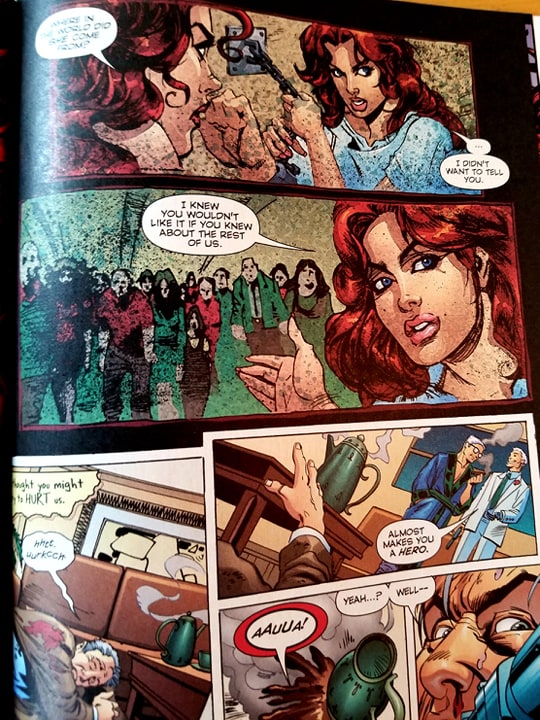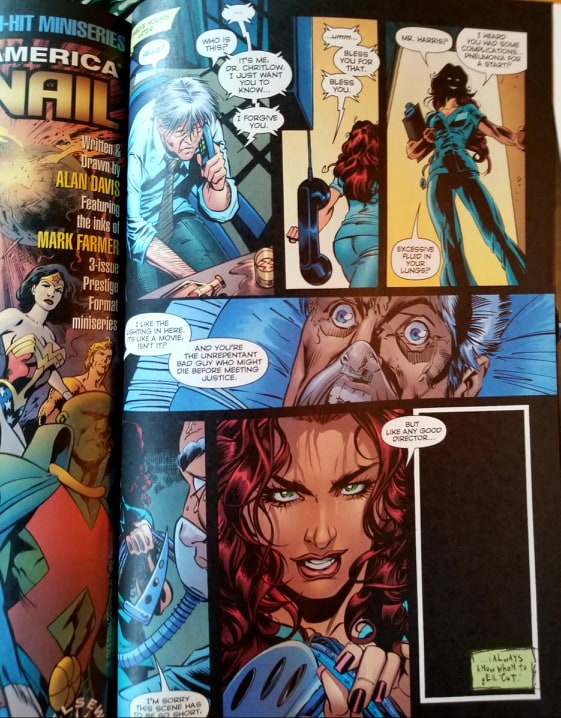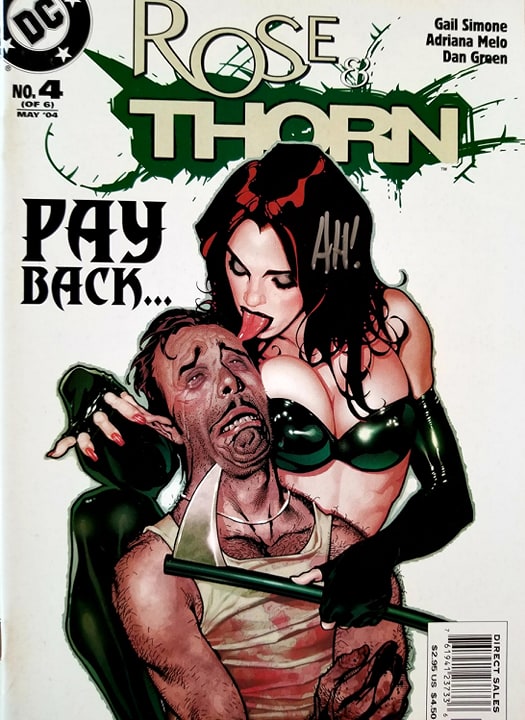
Writer: Gail Simone
Pencils: Adriana Melo
Inker: Dan Green
Colors: Alex Bleyaert
Letters: Rob Leigh
Covers: Adam Hughes
Publisher: DC Comics
Available: For the past 15 years, at cons and comic stores across America…
For my first entry in Paul’s “From the Bookshelf” section of the ‘Box, I’ll be looking at Gail Simone’s 2004 Rose & Thorn 6-issue miniseries from DC.
Truth be told, I didn’t engage Rose & Thorn until last spring, at C2E2. Frankly, having grown up in the early to mid-‘80’s a Marvel True Believer amongst a group of like-minded (read: anti-DC) collectors, then having been out of the hobby for an extended period, I just didn’t naturally attend to anything straight DC. Anyway, I’d been shopping for Adam Hughes’ Vampirella covers (the Frankie’s Comics #11 is freakin’ gorgeous), and one of the vendors I came across had a whole longbox of AH! covers, including my cherished Vampi #11 as well as the entire run of Rose & Thorn, the first four signed by The Man Himself and all at under $10. Curious (the covers were striking and really stood out from the crowd, the way Hughes’ work tends to), I made an offer on the whole pile, struck a bargain and went on my decidedly more merry way (I really wanted that Vampi 11!).
This ended up being one of my better purchases (among way too many purchases, my wife would gladly—and loudly—inform you) in the last two or three years’ worth of C2E2’s.
Gail Simone, you see, seems to have a particular penchant for reinterpreting and improving upon characters. We discussed her work on Red Sonja last week, and she’s credited with having created the “little yellow boxes” (differentiating ‘Pool’s consciousness from the writer’s, a seriously neat device) during her tenure on Deadpool, all of which is to say nothing of her work on Batgirl and Birds of Prey, which I’m told she had a little something to do with, and everything else the world’s favorite tweeter has been up to in the past 20 years.
Rose and Thorn has a bit of a meandering and circuitous history in DC Comics. Originally introduced in the Golden Age as Rose Canton in the pages of Flash Comics #89 in 1947, Rose and Thorn served as two distinct personalities housed within the same character, the Thorn aspect having the ability to control plants and being a really, really bad person. The character ended up serving as precursor to the much more popular Poison Ivy, who showed up in Batman in 1966. The two characters, with their near-identical ability profile (begging one to question the need for Poison Ivy in the first place, but I digress), actually had several not-terribly-pleasant interactions, with Ivy and Harley Quinn typically taking it to the lesser-abled Thorn. Prior to all that, however, the character was also reintroduced as Rhosyn Forrest in Lois Lane #105 in 1970…with the same dual identity, an expanded and reconfigured backstory, and no actual superpowers (this is the version featured in Rose & Thorn). Both incarnations made occasional appearances in various DC books through the ‘70’s, ‘80’s and ‘90’s, leading up to Simone’s book. Confused yet? Uh…yeah…me neither.
Anyway, what Simone found back in the early aughts, was a fun little sandbox of a character that she could play with however she wanted to.
And play, she did.
The book opens with a 12-y/o Rhosyn placed in psychiatric rehab for having mutilated Mr. Quince, a member of The 100 (a mob-like conglomeration of bad guys) who had himself murdered her parents. Upon her admission, she’s confronted by Dr. Chritlow, a psychiatrist specifically serving at the juvenile psychiatric facility in order to continue his ethically questionable experimental treatment of adolescent deviance. In essence, he creates the Thorn persona within Rhosyn, in a Jeckyll-and-Hyde-ian attempt to parse out the girl’s aggressive side, and lock it deep within her psyche.
Rhosyn is a model patient, and over the years of her internment is increasingly able to confine her Thorn aspect, other than an occasional blow-up when the otherwise submissive Rose finds herself threatened and/or enraged. Such as when a kind roommate is burned to death by an anarchistic peer…and Thorn mutilates the young woman. You know, like we do.

Eventually, successfully rehabilitated and all growsed up, Rhosyn is released to the world.
And old ghosts come back for their hauntings. Thorn gains greater and greater leverage, as young adult Rhosyn confronts The 100 and her parents’ betrayer. Only problem is that a rage-fueled teen is no match for a mob hit squad, alternate identity or not. So, how does Rose survive?

Track down the books and read for yourself. I promise it’ll be worth the effort.
Predictably, Simone’s writing is outstanding, and her take on the Rose/Thorn construct is engaging. Gritty and realistic, it makes for an entertaining read without demanding too much out of our suspension of disbelief; the psychology, if a little stretched, is believable enough for me to buy. And there’s enough twists and turns (and a gut punch of an ending) to keep things enthralling throughout.


Adriana Melo’s art more than does its job (which perhaps explains why Simone paired up with her again in 2018’s Plastic Man), selling the chaos, intensity and at times lunacy of the tale and setting. Strong and confidently drafted throughout, with Green’s inks and Bleyaert’s colors (and Leigh’s lettering) completing the imagery, alternating between light lines and bright colors for Rose and thick, bold lines and a darker, more menacing palette for Thorn.
Oh, and did I mention the Adam Hughes covers? I think I might have. They’re ok, too. Issue four here is my personal fave, though they’re all classic AH!. Worth the price of admission on their own.

Sadly, DC didn’t think enough of Rose & Thorn to give it a trade paperback version, nor is the series to be found on comiXology; DC’s National Comics brand briefly took a stab at a series back in 2012, but it didn’t last more than an issue (though it, at least, is on comiXology). So, you’re left to find it as I did—diving through the boxes at a con, or at your local comic store. Your best bet is to, like I did, look for Adam Hughes cover collections. Unsigned and in good shape, you should be able to find them for $4-$6 per book, and maybe score a bargain if you package them all together.
At any rate, it’ll make for a fun hunt—I mean, you get to look at Adam Hughes art, fer cripe’s sake! And the reward, should you capture your targets, will be substantial. Read on, True Believer, and we’ll see you on the flip side!
Score: 13 (of 13)
Review by Andy Patch, thePullbox.com